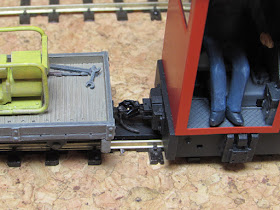Having decided to install uncouplers in typical uncoupling locations rather than rely wholly on delayed uncoupling, my installation has gone through some development. I initially installed MicroTrains' own magnets, however I discovered that they are not ideally suited for shunting individual O9 wagons as the wagons are the exact same length as the magnets, making for all sorts of accidental uncoupling incidents whilst trying to couple beyond the magnets. I am advised that it is possible to carefully score and snap the magnets to make two shorter ones, but that wasn't really something to try at 3pm on Christmas Eve!
I have therefore created my own magnets from pairs of 18 x 3 x 3mm ferrite magnets from Squires, set approx 0.75mm apart with a styrene strip between, and with some 0.5mm styrene underneath (L-R: individual magnet; magnets in position; the packet as bought):
Some experimentation soon finds the correct orientation of the magnets to attract the droppers on the MicroTrains couplings. The two magnets should attract each other along the sides, the two top poles are the same. I marked each magnet to show which way around it should sit before installing them with the magnet tops level with the rail head:
The sequence shows the magnets in use, starting with pulling up over the magnet and the couplings starting to feel the force of the magnet below:
Pulling apart the couplings are fully attracted to the side:
Pushing back together the couplings adopt the delayed position, should that be required to push a wagon further down the siding:
Obviously these magnets are still quite experimental, but that all adds to the fun!
Colin












